BigFoot Networks Killer NIC: Killer Marketing or Killer Product?
by Gary Key on October 31, 2006 2:00 AM EST- Posted in
- Networking
Gaming Performance
As usual, gaming performance was tested with a variety of current games. We ran benchmarks at our standard 1280x1024 resolution. Given the number of users that run 19 inch LCDs these days, 1280x1024 represents one of the most commonly used resolutions at this time.
Battlefield 2
This benchmark is probably the most intense one we ran as it occurred on the Daqing Oilfield map with 64 players battling it out in a chaotic frenzy. This was also the most difficult map we had to experience from a viewpoint of keeping our players together and trying to accomplish the same tasks. If you saw two players constantly missing the vehicle rides and spending a lot of time in the trees sniping then it was us. We ran Battlefield 2 using the highest quality graphics settings available in the video settings. The game itself is best experienced with average in-game frame rates of 40 and up.
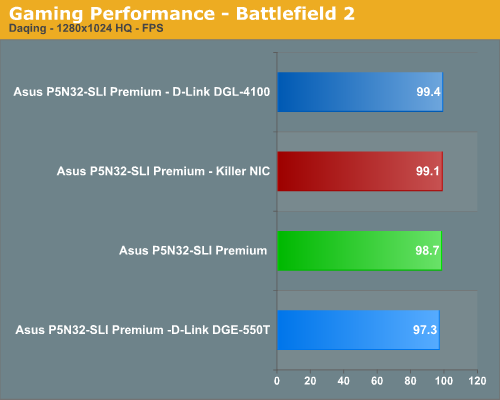

In our first game we actually find our D-Link combination performing slightly better than the other solutions from a benchmark viewpoint. During actual game play we noticed the frame rates and general smoothness of the system was best on the NVIDIA nForce 590SLI and followed closely by the Killer NIC. Several times during our testing with the D-Link DGL-4100 we would see several pauses while vehicles passed or several characters were in close proximity of each other. This behavior was worse on the D-Link DGE-550T when GameFuel was disabled on the router. In our first game we do not see $279.99 worth of game play improvement and the Killer NIC certainly did not allow us to dominate.
F.E.A.R.
We played both the Asylum and Deadwood 16-player maps. We decided to report the Asylum results as this is our favorite map currently. The Deadwood map generated similar results so we are not hiding any information. F.E.A.R. is a very graphics intensive game and we switch all graphic settings to maximum (except for soft shadows, which are disabled). An average frame rate for F.E.A.R. can dip into the teens at times which is not good for a first person shooter. We still found the game playable around 35fps or above in multiplayer.
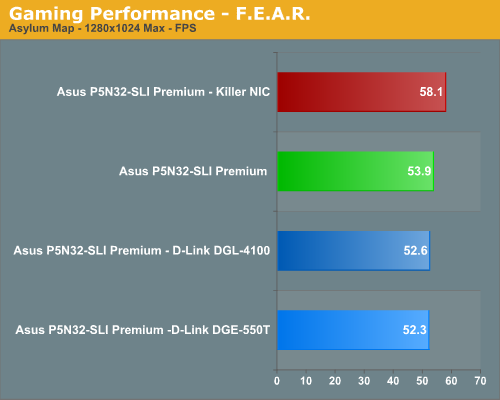

This is the money title for the Killer NIC. BigFoot Networks ships a copy of F.E.A.R. with every card so it should be expected to offer better frame rates and ping rates. We see a 7% increase in frame rates over the NVIDIA nForce 590SLI NIC and a 10% increase over the D-Link combination. In actual game play we found the Killer NIC to offer the most fluid experience and our ability to quickly transverse the map actually felt smoother than the other two solutions. The ping rates were actually higher than the D-Link router and nForce 590SLI but we did not find ping rate making a huge difference in this game. The question is did the Killer NIC improve our game play or skills? It really did not but it could for those who are significantly better players at this game than we are currently. In this case we will chalk a point up for the Killer NIC for improving frame rates.
Quake 4
This game should be a significant test for the Killer NIC as it requires extremely good hand to eye coordination along with lightning fast reflexes. This is just the game that would truly benefit from both improved ping and frame rates. We played on the Campgrounds Redux map with a total of 16 players. This is our favorite map from Quake III Arena and we were glad to see it return. We set our video settings to high and then fired up the game.
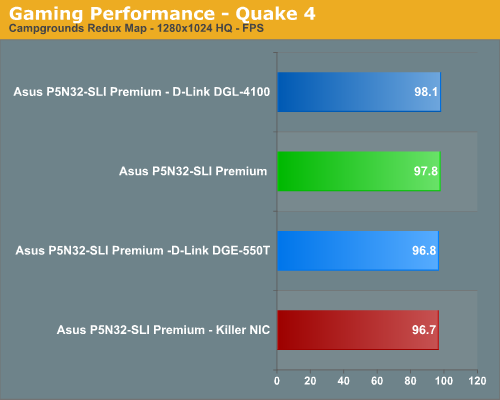
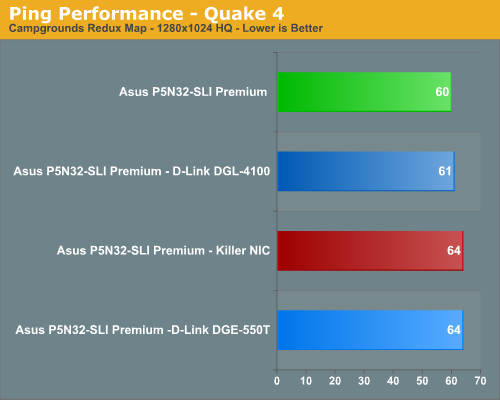
Actually, Quake 4 limits true frame rate to 60 fps during game play whether or not VSync is enabled. However, various timedemos and FRAPS will report the frame rate your system is capable of providing without the cap. In this case, we believe due to the speed of the game that ping rate is an extremely important performance measurement. This is one game where the Killer NIC loses on both fronts and it is mainly attributable to the excellent network code already provided in the game engine that does not benefit from offloading technology. The current performance leads us to believe we can expect to see the same results in the eagerly awaited Enemy Territory: Quake Wars.
Counter Strike Source
This is another game that BigFoot Networks touts as a premier title that will show improvements in both frame and ping rates. We are playing on the Office map with 32 players and we varied our online session times to ensure we were playing on a full server. Our settings were once again set to high quality at a 1280x1024 resolution. We find the game is very playable at 50 fps or better.
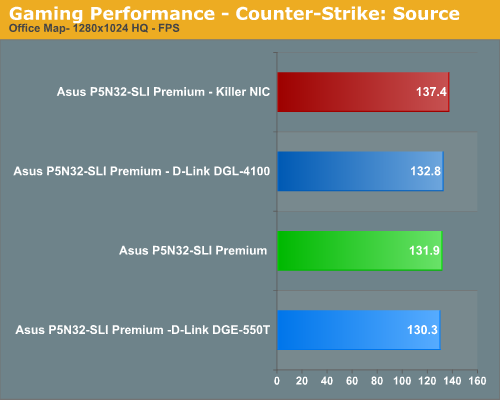

We did see frame rate improvements between three to five percent in this game. However, at these frame rates we really do not think a difference of 5% is going to matter much. Like Quake 4, an excellent ping rate in this game will make a difference and in this case we just did not see a large enough variation to make a difference in our experience. The Killer NIC did provide a positive experience to some degree in CSS as game play seemed to be a little smoother after firing your weapon than our other solutions. It was not a fire, frame hitch, and then move event we experienced a few other times during testing, especially with the D-Link PCI NIC. The Killer NIC gets a point for improving frame rates as advertised. We have to take it away for failing to improve our ping rates in a game where UltimatePing (reducing ping rates on the host system) could make a difference in actual game play.
Call of Duty 2
This is another popular shooter where frame rate and ping rate are very important especially in close quarters fighting. We played on the Caen map with a 24 player limit. The amount of packet processing this game generates is significantly higher at times than Counter Strike: Source so we expected our Killer NIC to shine in this area. Our video resolution is set to 1280x1024 with all options but AA enabled. We find the game is generally playable with a 40 fps or higher rate in multiplayer.
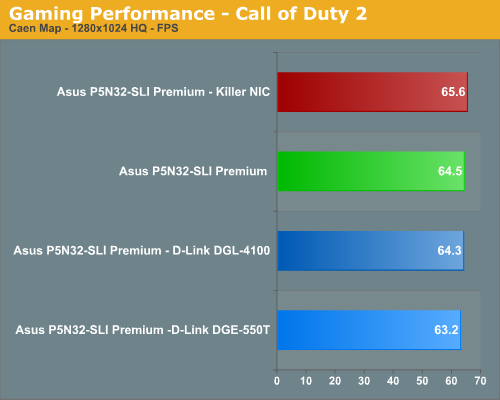
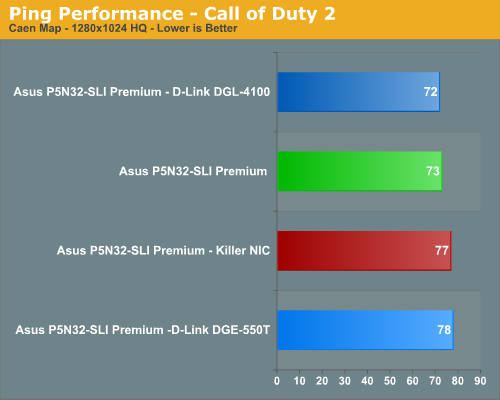
These results surprised us as we see minor frame rate improvements but ping rates were up to 7% greater than our D-Link router or NVIDIA NIC. The frame rate improvement is only worth mentioning because this game is generally GPU bound so any benchmark differences between systems is noticeable. Were the frame rate differences during game play noticeable? No they were not but we can tell you the increased ping rates were noticeable. This was the first game we encountered where the actual game play was not smooth with the Killer NIC. We noticed choppy break points at certain sections, especially when going building to building in the center of the map. We tried this map at different times during the day and noticed this issue several times. It seemed to be worse when throwing a grenade as we blew our selves up twice during testing. We might be slow and have weak arms in real life but our game characters did not need this handicap.
As usual, gaming performance was tested with a variety of current games. We ran benchmarks at our standard 1280x1024 resolution. Given the number of users that run 19 inch LCDs these days, 1280x1024 represents one of the most commonly used resolutions at this time.
Battlefield 2
This benchmark is probably the most intense one we ran as it occurred on the Daqing Oilfield map with 64 players battling it out in a chaotic frenzy. This was also the most difficult map we had to experience from a viewpoint of keeping our players together and trying to accomplish the same tasks. If you saw two players constantly missing the vehicle rides and spending a lot of time in the trees sniping then it was us. We ran Battlefield 2 using the highest quality graphics settings available in the video settings. The game itself is best experienced with average in-game frame rates of 40 and up.


In our first game we actually find our D-Link combination performing slightly better than the other solutions from a benchmark viewpoint. During actual game play we noticed the frame rates and general smoothness of the system was best on the NVIDIA nForce 590SLI and followed closely by the Killer NIC. Several times during our testing with the D-Link DGL-4100 we would see several pauses while vehicles passed or several characters were in close proximity of each other. This behavior was worse on the D-Link DGE-550T when GameFuel was disabled on the router. In our first game we do not see $279.99 worth of game play improvement and the Killer NIC certainly did not allow us to dominate.
F.E.A.R.
We played both the Asylum and Deadwood 16-player maps. We decided to report the Asylum results as this is our favorite map currently. The Deadwood map generated similar results so we are not hiding any information. F.E.A.R. is a very graphics intensive game and we switch all graphic settings to maximum (except for soft shadows, which are disabled). An average frame rate for F.E.A.R. can dip into the teens at times which is not good for a first person shooter. We still found the game playable around 35fps or above in multiplayer.


This is the money title for the Killer NIC. BigFoot Networks ships a copy of F.E.A.R. with every card so it should be expected to offer better frame rates and ping rates. We see a 7% increase in frame rates over the NVIDIA nForce 590SLI NIC and a 10% increase over the D-Link combination. In actual game play we found the Killer NIC to offer the most fluid experience and our ability to quickly transverse the map actually felt smoother than the other two solutions. The ping rates were actually higher than the D-Link router and nForce 590SLI but we did not find ping rate making a huge difference in this game. The question is did the Killer NIC improve our game play or skills? It really did not but it could for those who are significantly better players at this game than we are currently. In this case we will chalk a point up for the Killer NIC for improving frame rates.
Quake 4
This game should be a significant test for the Killer NIC as it requires extremely good hand to eye coordination along with lightning fast reflexes. This is just the game that would truly benefit from both improved ping and frame rates. We played on the Campgrounds Redux map with a total of 16 players. This is our favorite map from Quake III Arena and we were glad to see it return. We set our video settings to high and then fired up the game.


Actually, Quake 4 limits true frame rate to 60 fps during game play whether or not VSync is enabled. However, various timedemos and FRAPS will report the frame rate your system is capable of providing without the cap. In this case, we believe due to the speed of the game that ping rate is an extremely important performance measurement. This is one game where the Killer NIC loses on both fronts and it is mainly attributable to the excellent network code already provided in the game engine that does not benefit from offloading technology. The current performance leads us to believe we can expect to see the same results in the eagerly awaited Enemy Territory: Quake Wars.
Counter Strike Source
This is another game that BigFoot Networks touts as a premier title that will show improvements in both frame and ping rates. We are playing on the Office map with 32 players and we varied our online session times to ensure we were playing on a full server. Our settings were once again set to high quality at a 1280x1024 resolution. We find the game is very playable at 50 fps or better.


We did see frame rate improvements between three to five percent in this game. However, at these frame rates we really do not think a difference of 5% is going to matter much. Like Quake 4, an excellent ping rate in this game will make a difference and in this case we just did not see a large enough variation to make a difference in our experience. The Killer NIC did provide a positive experience to some degree in CSS as game play seemed to be a little smoother after firing your weapon than our other solutions. It was not a fire, frame hitch, and then move event we experienced a few other times during testing, especially with the D-Link PCI NIC. The Killer NIC gets a point for improving frame rates as advertised. We have to take it away for failing to improve our ping rates in a game where UltimatePing (reducing ping rates on the host system) could make a difference in actual game play.
Call of Duty 2
This is another popular shooter where frame rate and ping rate are very important especially in close quarters fighting. We played on the Caen map with a 24 player limit. The amount of packet processing this game generates is significantly higher at times than Counter Strike: Source so we expected our Killer NIC to shine in this area. Our video resolution is set to 1280x1024 with all options but AA enabled. We find the game is generally playable with a 40 fps or higher rate in multiplayer.


These results surprised us as we see minor frame rate improvements but ping rates were up to 7% greater than our D-Link router or NVIDIA NIC. The frame rate improvement is only worth mentioning because this game is generally GPU bound so any benchmark differences between systems is noticeable. Were the frame rate differences during game play noticeable? No they were not but we can tell you the increased ping rates were noticeable. This was the first game we encountered where the actual game play was not smooth with the Killer NIC. We noticed choppy break points at certain sections, especially when going building to building in the center of the map. We tried this map at different times during the day and noticed this issue several times. It seemed to be worse when throwing a grenade as we blew our selves up twice during testing. We might be slow and have weak arms in real life but our game characters did not need this handicap.










87 Comments
View All Comments
Gary Key - Wednesday, November 1, 2006 - link
We have been trying to develop a benchmark for BF2142 and our issues always revolve around the Titan when it is full. ;-) I tried BF2142 right before we ended testing with the Killer NIC and could not tell any difference with it. However, I did not benchmark while we were trying to develop a benchmark. If I get a chance I will go back and try it with the new drivers.soydeedo - Wednesday, November 1, 2006 - link
cool beans. thanks for that quick first impression. i was just curious if it could somehow benefit from the packet optimization etc. anywho, keep us posted should you find something noteworthy with the new drivers. =)goinginstyle - Wednesday, November 29, 2006 - link
Any update on BF2142?Nehemoth - Tuesday, October 31, 2006 - link
Now i just need that anandtech review thishttp://www.hfield.com/wifire.htm">http://www.hfield.com/wifire.htm
yyrkoon - Wednesday, November 1, 2006 - link
Looks like a flat panel, and you'd do better with a 21-23DB gain Andrew, trust me, I've had the last two years to play with both since we've been wireless internet for about that long. We have just now switched (tonight, just got he hardware) to AT&T 'Wi-Max', and it is much much better than our previous provider using 802.11/G. Get this, it doesnt even need a dirrectional, just set it next to a window (such is true in our case), and you're getting an instant 2.52Mbit from a tower 8 miles away.It's pretty dahmed cool, and I didnt believe it myself, until I hooked up a neibors system for him, and he's got it in a window that sits on the opposite side of his house from the tower. Although, from the little technical information the tech support team was able to provide me with, it's only availible in our town, and only if you cant get DSL, supposedly, this is some sort of trial service for them, to determine whether its feasable to setup in other areas *shrug*. Nothing like downloading at 200 KB/s +, seen it swing as high as 800+ KB/s
feelingshorter - Tuesday, October 31, 2006 - link
Buddy, that thing is realistic. Dont tell me you never herd of a directional antenna?!?!? Thats all it is. No its not overpriced because good antennas cost a lot and it does stop your internet from dropping.Frumious1 - Tuesday, October 31, 2006 - link
Only problem is it's completely impractical for laptops where you move around a lot. For desktops, if you want a consistent quality connection, just run the damn wire and be done with it. The fastest wireless 802.11 stuff can't even come close to 100 Mbit for typical use, let alone gigabit!yyrkoon - Tuesday, October 31, 2006 - link
I have to admit, I'm a bit disappointed in you fellas, for not even benching the in-expensive Intel PCI-E NIC http://www.tigerdirect.com/applications/searchtool...">Intel Pro 1000 PCI-E, Or atleast comparring the two. For $40 USD, this card should perform very close, if not better than the $300usd 'snake oil' NIC.
*sigh*
Gary Key - Tuesday, October 31, 2006 - link
We tested the Intel PRO/1000 PT and the Koutech PEN120 PCI-Express Gigabit adapters. Both adapters scored slightly less than the NIVIDIA NIC across the board in our tests so we did not show the results. Both cards support Linux so that is a plus but then again we were reviewing a NIC designed for Windows based gaming.yyrkoon - Wednesday, November 1, 2006 - link
Hmm, guess i missed that review, however, the last review on saw on the Intel PCI, and Onboard Intel solutions (a year or so ago from *ahem* THW, showed both those leading the pack, of course, I guess the killer NIC wasnt availible at that time . . .